Taxation Law Assignment: Comprehensive Analysis of Tax Law Questions
VerifiedAdded on 2022/09/17
|19
|3519
|12
Homework Assignment
AI Summary
This taxation law assignment provides detailed answers to several questions covering key aspects of Australian tax law. The assignment begins with an analysis of relevant taxation rulings, defining when a company carries on a business and explaining the rules for deductions related to gifts and contributions. It then addresses the top marginal tax rate for Australian residents and clarifies the treatment of assets like motorcycles and cars under capital gains tax (CGT). The assignment explores CGT event C1, the tax-free threshold, and the distinction between ordinary and statutory income, along with the differences between the Medicare Levy and Medicare Levy Surcharge. Further, the assignment delves into determining residency status, referencing key cases and rulings. It also analyzes the deductibility of various expenses, including HECS-HELP contributions, travel, books, childcare, home repairs, clothing, and legal fees related to employment. Finally, the assignment addresses capital gains tax events related to the lease of land, providing a comprehensive overview of relevant tax concepts and their application.
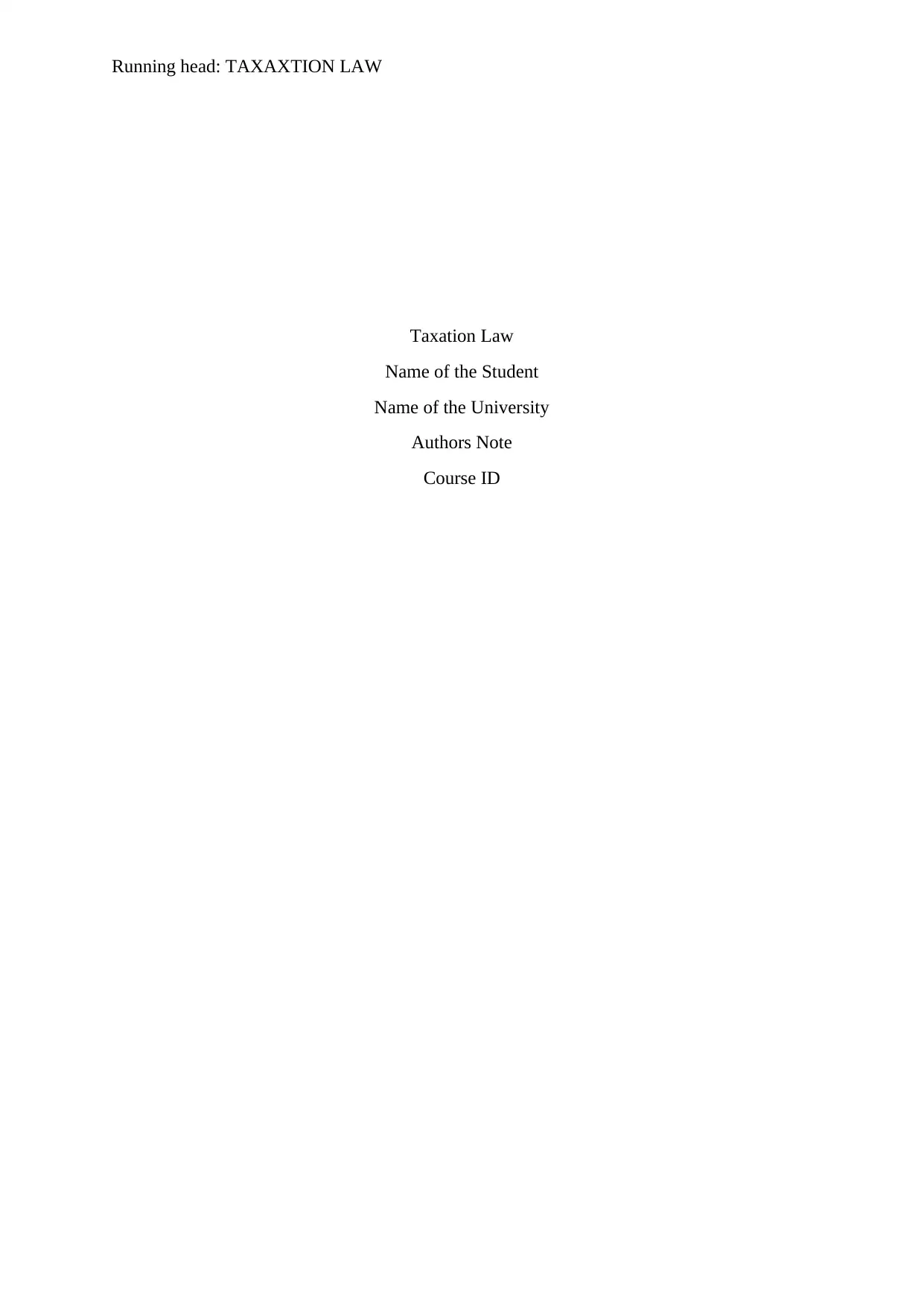
Running head: TAXAXTION LAW
Taxation Law
Name of the Student
Name of the University
Authors Note
Course ID
Taxation Law
Name of the Student
Name of the University
Authors Note
Course ID
Paraphrase This Document
Need a fresh take? Get an instant paraphrase of this document with our AI Paraphraser
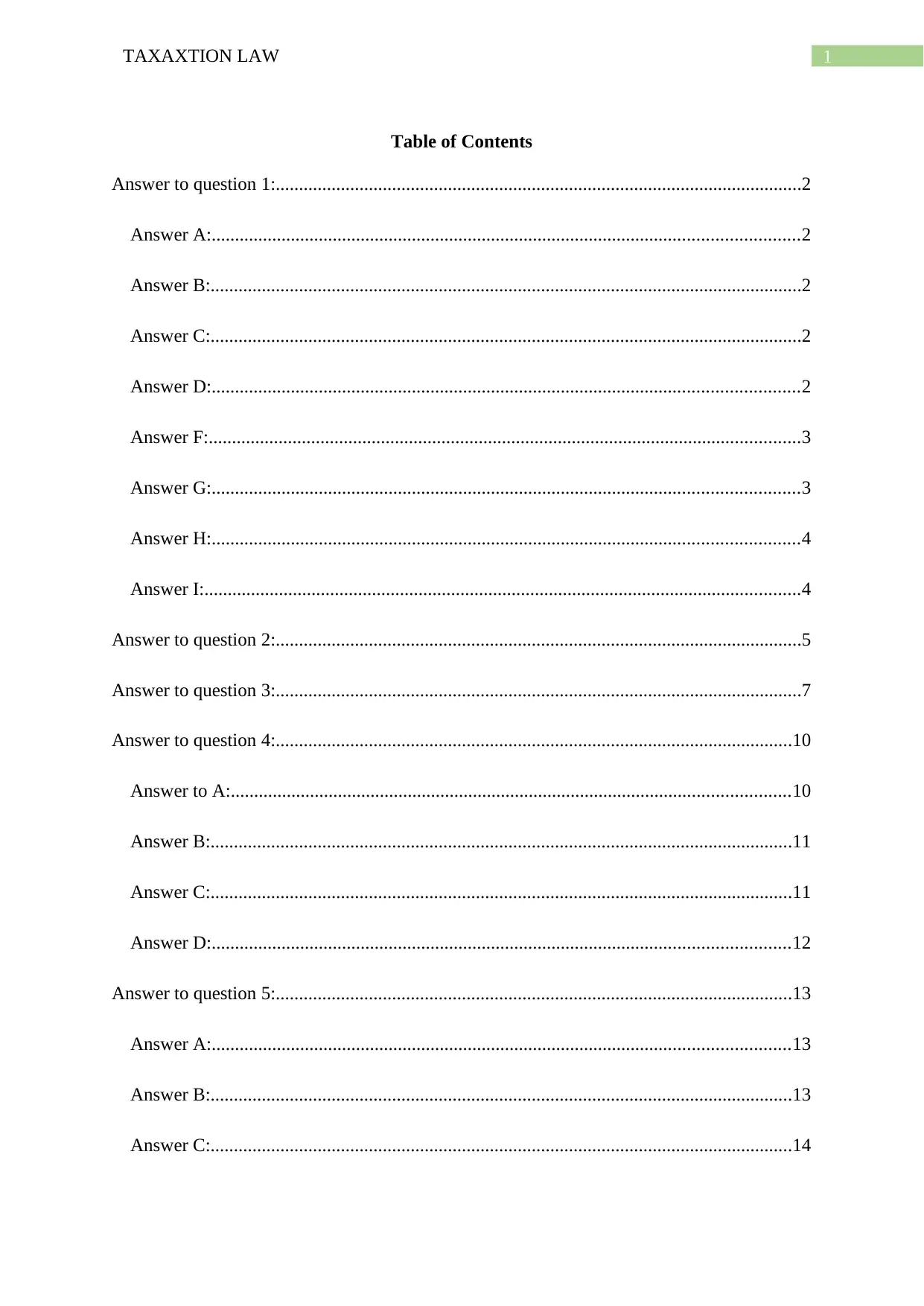
1TAXAXTION LAW
Table of Contents
Answer to question 1:.................................................................................................................2
Answer A:..............................................................................................................................2
Answer B:...............................................................................................................................2
Answer C:...............................................................................................................................2
Answer D:..............................................................................................................................2
Answer F:...............................................................................................................................3
Answer G:..............................................................................................................................3
Answer H:..............................................................................................................................4
Answer I:................................................................................................................................4
Answer to question 2:.................................................................................................................5
Answer to question 3:.................................................................................................................7
Answer to question 4:...............................................................................................................10
Answer to A:........................................................................................................................10
Answer B:.............................................................................................................................11
Answer C:.............................................................................................................................11
Answer D:............................................................................................................................12
Answer to question 5:...............................................................................................................13
Answer A:............................................................................................................................13
Answer B:.............................................................................................................................13
Answer C:.............................................................................................................................14
Table of Contents
Answer to question 1:.................................................................................................................2
Answer A:..............................................................................................................................2
Answer B:...............................................................................................................................2
Answer C:...............................................................................................................................2
Answer D:..............................................................................................................................2
Answer F:...............................................................................................................................3
Answer G:..............................................................................................................................3
Answer H:..............................................................................................................................4
Answer I:................................................................................................................................4
Answer to question 2:.................................................................................................................5
Answer to question 3:.................................................................................................................7
Answer to question 4:...............................................................................................................10
Answer to A:........................................................................................................................10
Answer B:.............................................................................................................................11
Answer C:.............................................................................................................................11
Answer D:............................................................................................................................12
Answer to question 5:...............................................................................................................13
Answer A:............................................................................................................................13
Answer B:.............................................................................................................................13
Answer C:.............................................................................................................................14
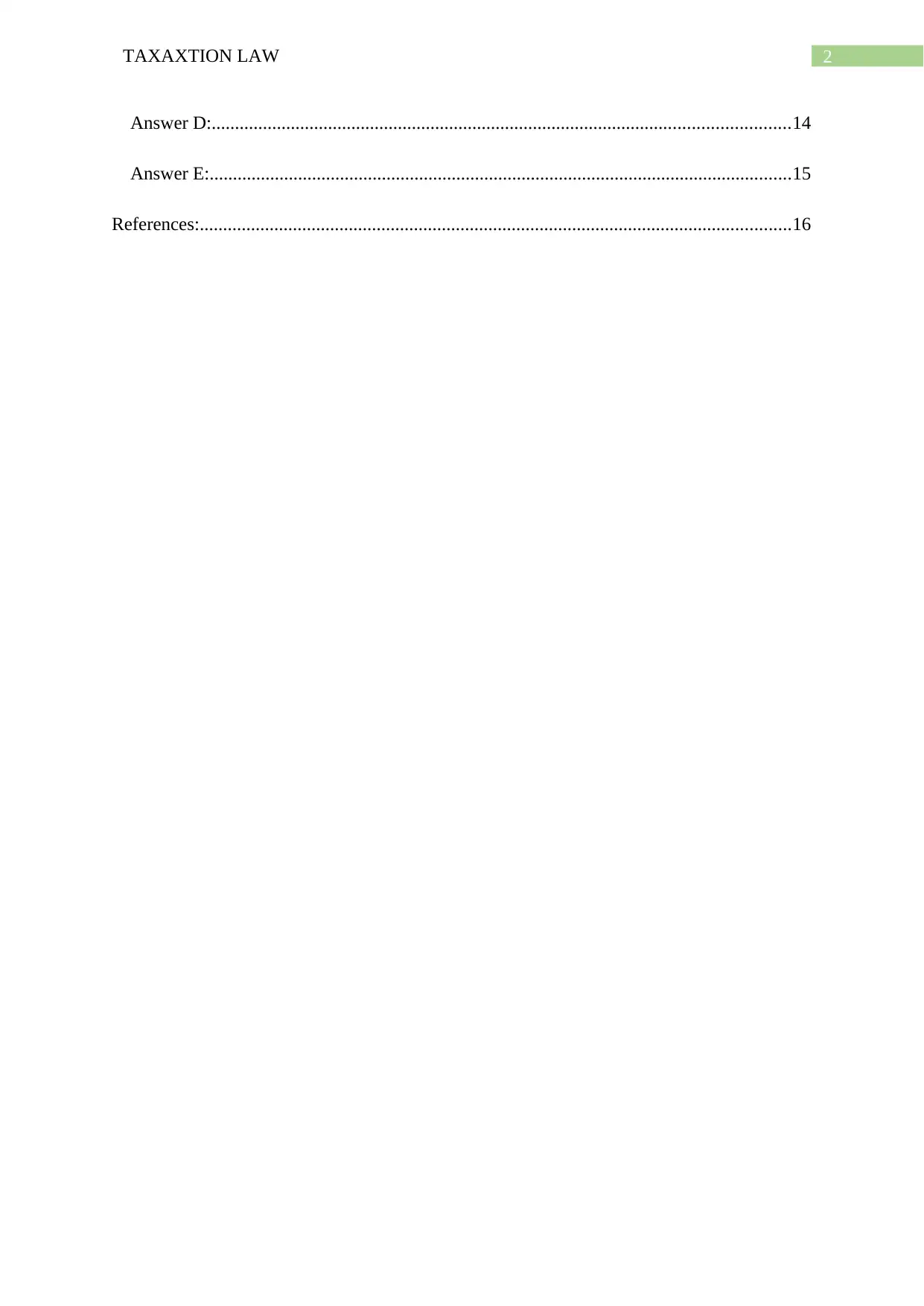
2TAXAXTION LAW
Answer D:............................................................................................................................14
Answer E:.............................................................................................................................15
References:...............................................................................................................................16
Answer D:............................................................................................................................14
Answer E:.............................................................................................................................15
References:...............................................................................................................................16
⊘ This is a preview!⊘
Do you want full access?
Subscribe today to unlock all pages.

Trusted by 1+ million students worldwide
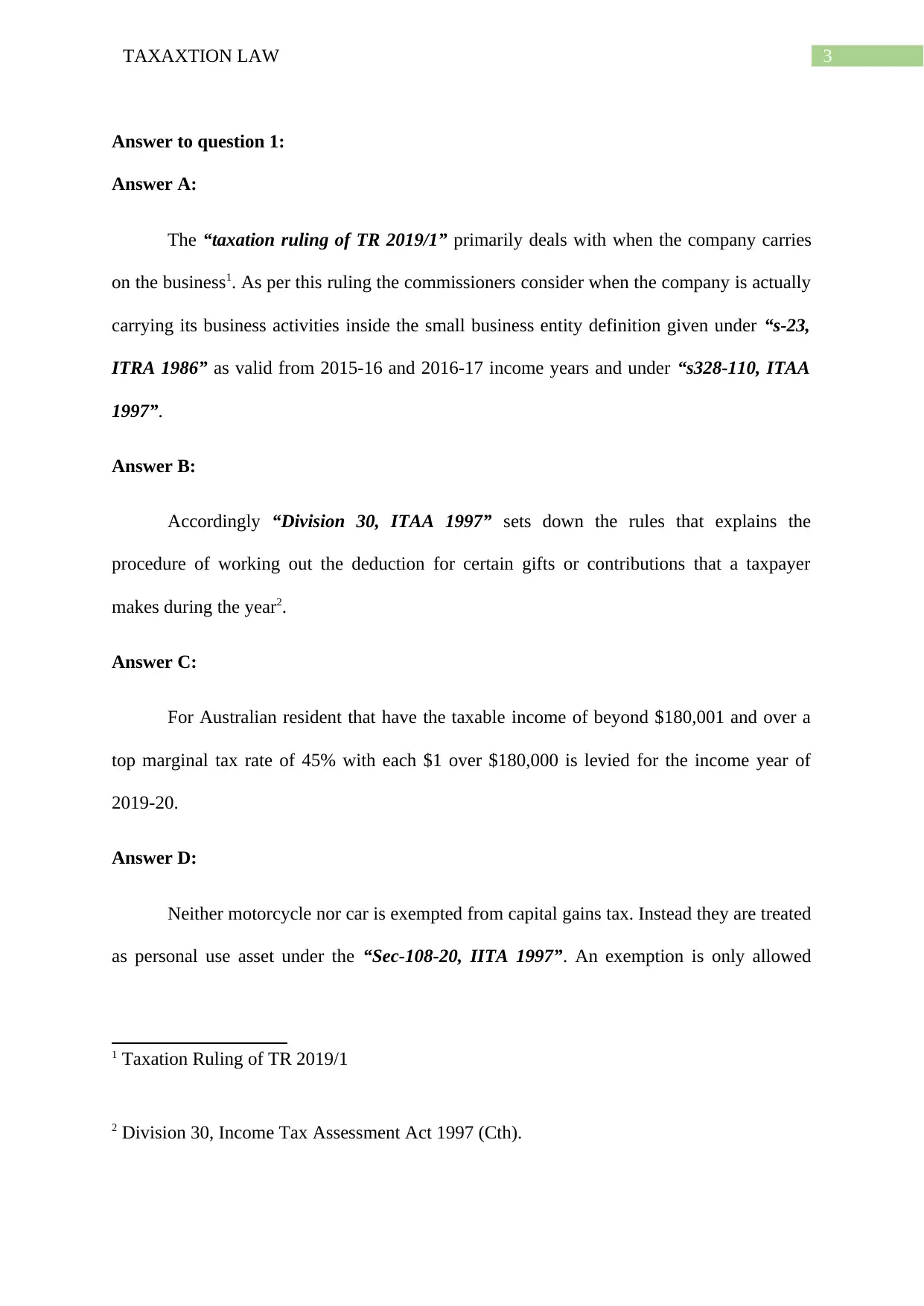
3TAXAXTION LAW
Answer to question 1:
Answer A:
The “taxation ruling of TR 2019/1” primarily deals with when the company carries
on the business1. As per this ruling the commissioners consider when the company is actually
carrying its business activities inside the small business entity definition given under “s-23,
ITRA 1986” as valid from 2015-16 and 2016-17 income years and under “s328-110, ITAA
1997”.
Answer B:
Accordingly “Division 30, ITAA 1997” sets down the rules that explains the
procedure of working out the deduction for certain gifts or contributions that a taxpayer
makes during the year2.
Answer C:
For Australian resident that have the taxable income of beyond $180,001 and over a
top marginal tax rate of 45% with each $1 over $180,000 is levied for the income year of
2019-20.
Answer D:
Neither motorcycle nor car is exempted from capital gains tax. Instead they are treated
as personal use asset under the “Sec-108-20, IITA 1997”. An exemption is only allowed
1 Taxation Ruling of TR 2019/1
2 Division 30, Income Tax Assessment Act 1997 (Cth).
Answer to question 1:
Answer A:
The “taxation ruling of TR 2019/1” primarily deals with when the company carries
on the business1. As per this ruling the commissioners consider when the company is actually
carrying its business activities inside the small business entity definition given under “s-23,
ITRA 1986” as valid from 2015-16 and 2016-17 income years and under “s328-110, ITAA
1997”.
Answer B:
Accordingly “Division 30, ITAA 1997” sets down the rules that explains the
procedure of working out the deduction for certain gifts or contributions that a taxpayer
makes during the year2.
Answer C:
For Australian resident that have the taxable income of beyond $180,001 and over a
top marginal tax rate of 45% with each $1 over $180,000 is levied for the income year of
2019-20.
Answer D:
Neither motorcycle nor car is exempted from capital gains tax. Instead they are treated
as personal use asset under the “Sec-108-20, IITA 1997”. An exemption is only allowed
1 Taxation Ruling of TR 2019/1
2 Division 30, Income Tax Assessment Act 1997 (Cth).
Paraphrase This Document
Need a fresh take? Get an instant paraphrase of this document with our AI Paraphraser
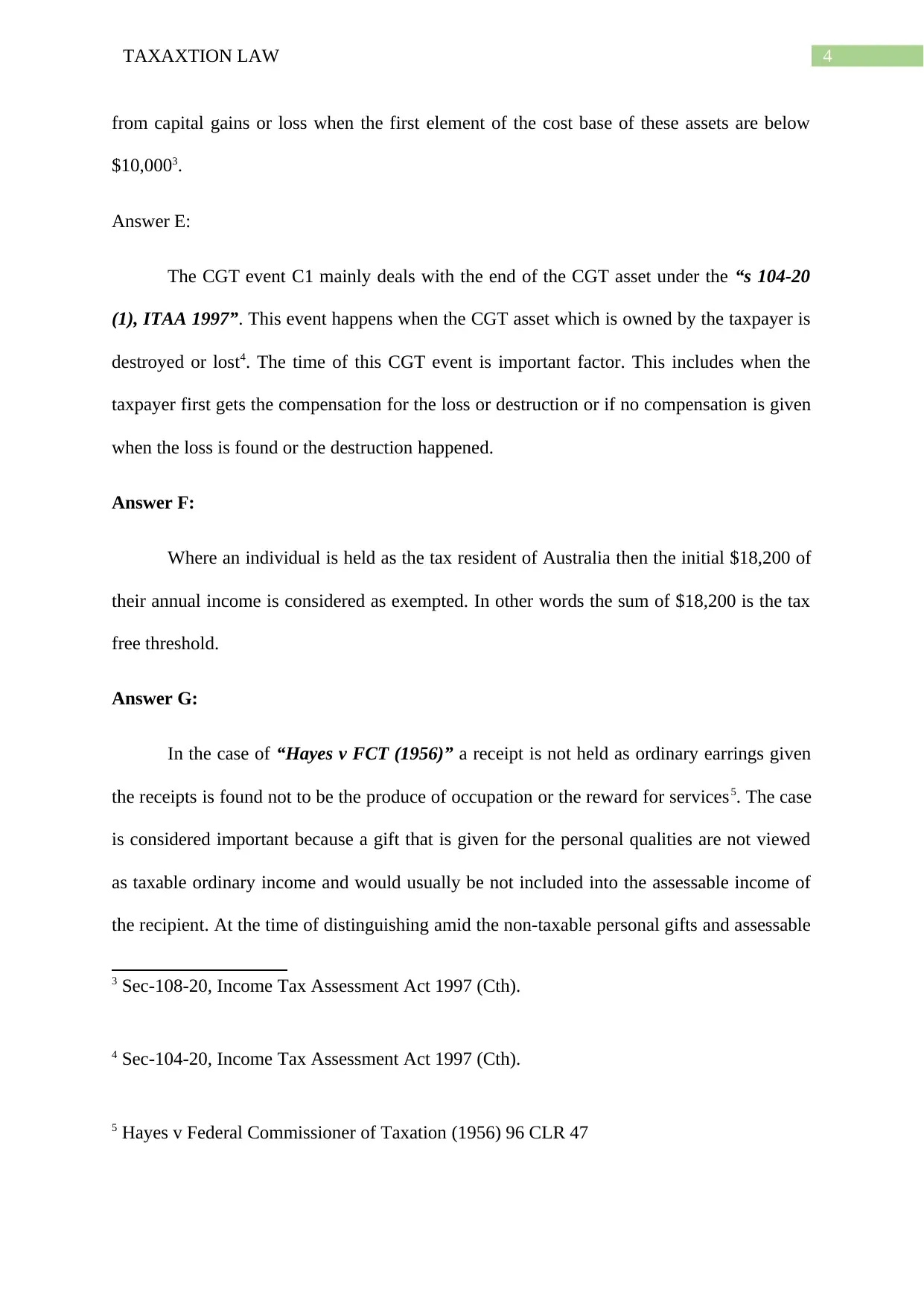
4TAXAXTION LAW
from capital gains or loss when the first element of the cost base of these assets are below
$10,0003.
Answer E:
The CGT event C1 mainly deals with the end of the CGT asset under the “s 104-20
(1), ITAA 1997”. This event happens when the CGT asset which is owned by the taxpayer is
destroyed or lost4. The time of this CGT event is important factor. This includes when the
taxpayer first gets the compensation for the loss or destruction or if no compensation is given
when the loss is found or the destruction happened.
Answer F:
Where an individual is held as the tax resident of Australia then the initial $18,200 of
their annual income is considered as exempted. In other words the sum of $18,200 is the tax
free threshold.
Answer G:
In the case of “Hayes v FCT (1956)” a receipt is not held as ordinary earrings given
the receipts is found not to be the produce of occupation or the reward for services5. The case
is considered important because a gift that is given for the personal qualities are not viewed
as taxable ordinary income and would usually be not included into the assessable income of
the recipient. At the time of distinguishing amid the non-taxable personal gifts and assessable
3 Sec-108-20, Income Tax Assessment Act 1997 (Cth).
4 Sec-104-20, Income Tax Assessment Act 1997 (Cth).
5 Hayes v Federal Commissioner of Taxation (1956) 96 CLR 47
from capital gains or loss when the first element of the cost base of these assets are below
$10,0003.
Answer E:
The CGT event C1 mainly deals with the end of the CGT asset under the “s 104-20
(1), ITAA 1997”. This event happens when the CGT asset which is owned by the taxpayer is
destroyed or lost4. The time of this CGT event is important factor. This includes when the
taxpayer first gets the compensation for the loss or destruction or if no compensation is given
when the loss is found or the destruction happened.
Answer F:
Where an individual is held as the tax resident of Australia then the initial $18,200 of
their annual income is considered as exempted. In other words the sum of $18,200 is the tax
free threshold.
Answer G:
In the case of “Hayes v FCT (1956)” a receipt is not held as ordinary earrings given
the receipts is found not to be the produce of occupation or the reward for services5. The case
is considered important because a gift that is given for the personal qualities are not viewed
as taxable ordinary income and would usually be not included into the assessable income of
the recipient. At the time of distinguishing amid the non-taxable personal gifts and assessable
3 Sec-108-20, Income Tax Assessment Act 1997 (Cth).
4 Sec-104-20, Income Tax Assessment Act 1997 (Cth).
5 Hayes v Federal Commissioner of Taxation (1956) 96 CLR 47
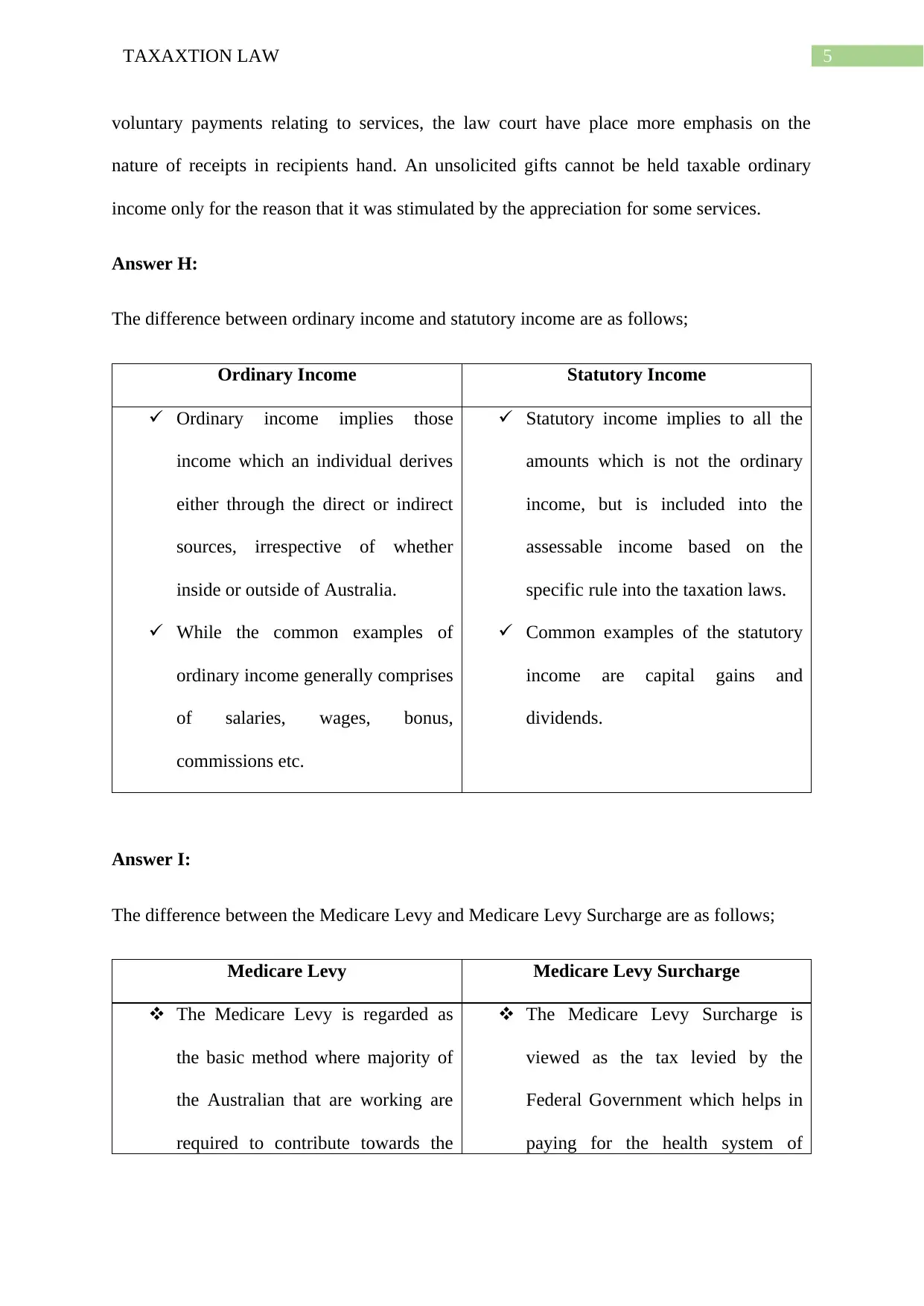
5TAXAXTION LAW
voluntary payments relating to services, the law court have place more emphasis on the
nature of receipts in recipients hand. An unsolicited gifts cannot be held taxable ordinary
income only for the reason that it was stimulated by the appreciation for some services.
Answer H:
The difference between ordinary income and statutory income are as follows;
Ordinary Income Statutory Income
Ordinary income implies those
income which an individual derives
either through the direct or indirect
sources, irrespective of whether
inside or outside of Australia.
While the common examples of
ordinary income generally comprises
of salaries, wages, bonus,
commissions etc.
Statutory income implies to all the
amounts which is not the ordinary
income, but is included into the
assessable income based on the
specific rule into the taxation laws.
Common examples of the statutory
income are capital gains and
dividends.
Answer I:
The difference between the Medicare Levy and Medicare Levy Surcharge are as follows;
Medicare Levy Medicare Levy Surcharge
The Medicare Levy is regarded as
the basic method where majority of
the Australian that are working are
required to contribute towards the
The Medicare Levy Surcharge is
viewed as the tax levied by the
Federal Government which helps in
paying for the health system of
voluntary payments relating to services, the law court have place more emphasis on the
nature of receipts in recipients hand. An unsolicited gifts cannot be held taxable ordinary
income only for the reason that it was stimulated by the appreciation for some services.
Answer H:
The difference between ordinary income and statutory income are as follows;
Ordinary Income Statutory Income
Ordinary income implies those
income which an individual derives
either through the direct or indirect
sources, irrespective of whether
inside or outside of Australia.
While the common examples of
ordinary income generally comprises
of salaries, wages, bonus,
commissions etc.
Statutory income implies to all the
amounts which is not the ordinary
income, but is included into the
assessable income based on the
specific rule into the taxation laws.
Common examples of the statutory
income are capital gains and
dividends.
Answer I:
The difference between the Medicare Levy and Medicare Levy Surcharge are as follows;
Medicare Levy Medicare Levy Surcharge
The Medicare Levy is regarded as
the basic method where majority of
the Australian that are working are
required to contribute towards the
The Medicare Levy Surcharge is
viewed as the tax levied by the
Federal Government which helps in
paying for the health system of
⊘ This is a preview!⊘
Do you want full access?
Subscribe today to unlock all pages.

Trusted by 1+ million students worldwide
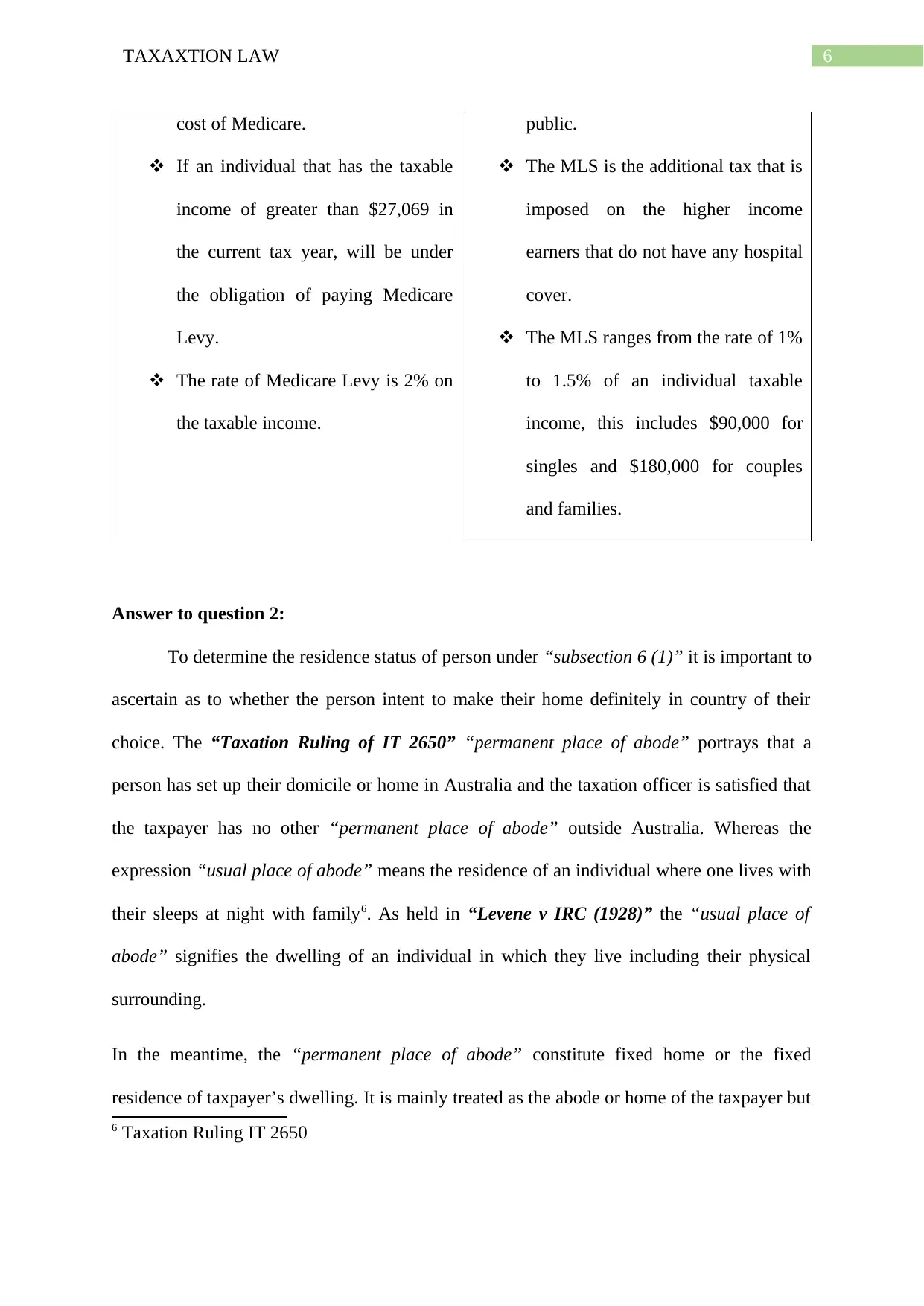
6TAXAXTION LAW
cost of Medicare.
If an individual that has the taxable
income of greater than $27,069 in
the current tax year, will be under
the obligation of paying Medicare
Levy.
The rate of Medicare Levy is 2% on
the taxable income.
public.
The MLS is the additional tax that is
imposed on the higher income
earners that do not have any hospital
cover.
The MLS ranges from the rate of 1%
to 1.5% of an individual taxable
income, this includes $90,000 for
singles and $180,000 for couples
and families.
Answer to question 2:
To determine the residence status of person under “subsection 6 (1)” it is important to
ascertain as to whether the person intent to make their home definitely in country of their
choice. The “Taxation Ruling of IT 2650” “permanent place of abode” portrays that a
person has set up their domicile or home in Australia and the taxation officer is satisfied that
the taxpayer has no other “permanent place of abode” outside Australia. Whereas the
expression “usual place of abode” means the residence of an individual where one lives with
their sleeps at night with family6. As held in “Levene v IRC (1928)” the “usual place of
abode” signifies the dwelling of an individual in which they live including their physical
surrounding.
In the meantime, the “permanent place of abode” constitute fixed home or the fixed
residence of taxpayer’s dwelling. It is mainly treated as the abode or home of the taxpayer but
6 Taxation Ruling IT 2650
cost of Medicare.
If an individual that has the taxable
income of greater than $27,069 in
the current tax year, will be under
the obligation of paying Medicare
Levy.
The rate of Medicare Levy is 2% on
the taxable income.
public.
The MLS is the additional tax that is
imposed on the higher income
earners that do not have any hospital
cover.
The MLS ranges from the rate of 1%
to 1.5% of an individual taxable
income, this includes $90,000 for
singles and $180,000 for couples
and families.
Answer to question 2:
To determine the residence status of person under “subsection 6 (1)” it is important to
ascertain as to whether the person intent to make their home definitely in country of their
choice. The “Taxation Ruling of IT 2650” “permanent place of abode” portrays that a
person has set up their domicile or home in Australia and the taxation officer is satisfied that
the taxpayer has no other “permanent place of abode” outside Australia. Whereas the
expression “usual place of abode” means the residence of an individual where one lives with
their sleeps at night with family6. As held in “Levene v IRC (1928)” the “usual place of
abode” signifies the dwelling of an individual in which they live including their physical
surrounding.
In the meantime, the “permanent place of abode” constitute fixed home or the fixed
residence of taxpayer’s dwelling. It is mainly treated as the abode or home of the taxpayer but
6 Taxation Ruling IT 2650
Paraphrase This Document
Need a fresh take? Get an instant paraphrase of this document with our AI Paraphraser
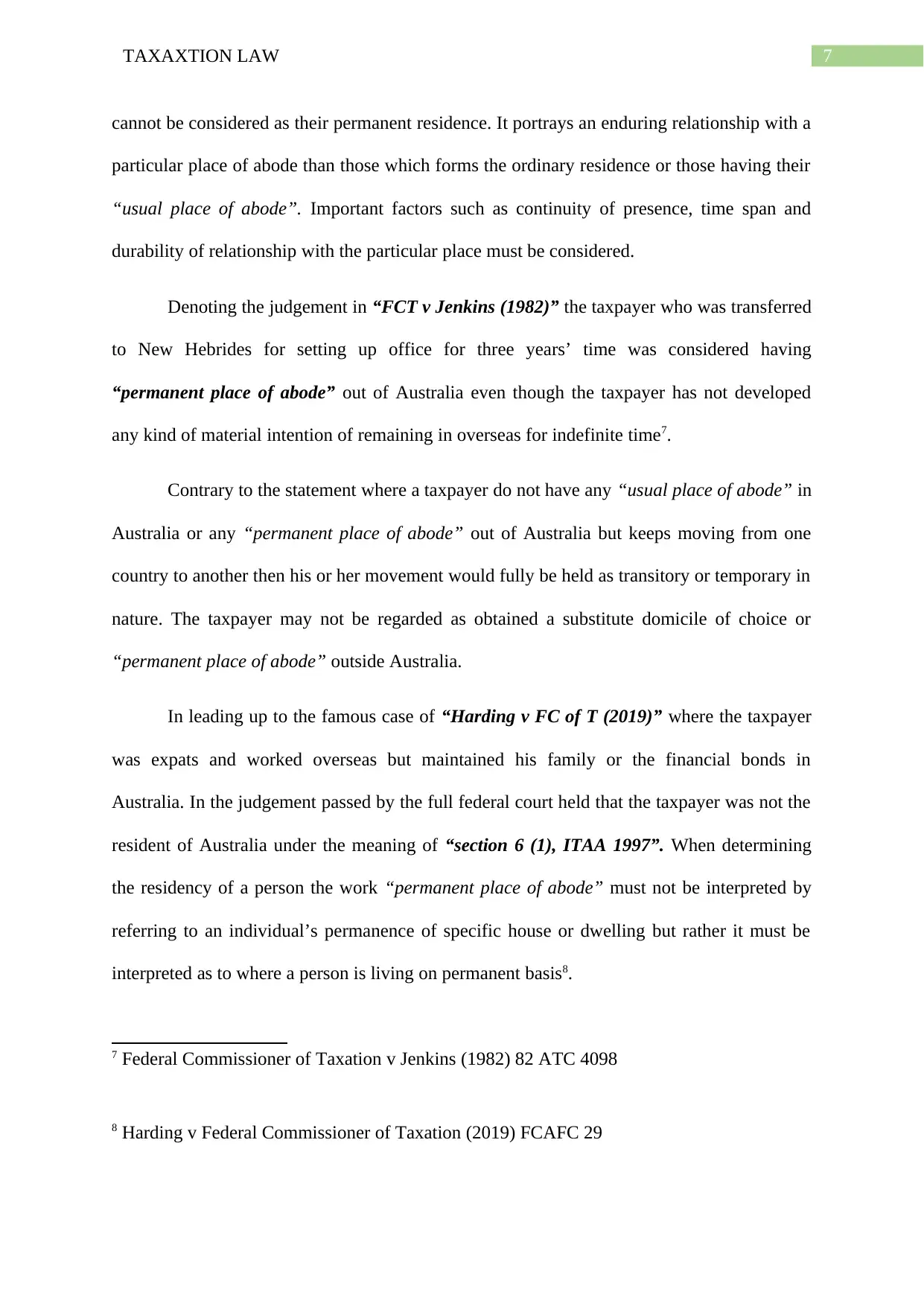
7TAXAXTION LAW
cannot be considered as their permanent residence. It portrays an enduring relationship with a
particular place of abode than those which forms the ordinary residence or those having their
“usual place of abode”. Important factors such as continuity of presence, time span and
durability of relationship with the particular place must be considered.
Denoting the judgement in “FCT v Jenkins (1982)” the taxpayer who was transferred
to New Hebrides for setting up office for three years’ time was considered having
“permanent place of abode” out of Australia even though the taxpayer has not developed
any kind of material intention of remaining in overseas for indefinite time7.
Contrary to the statement where a taxpayer do not have any “usual place of abode” in
Australia or any “permanent place of abode” out of Australia but keeps moving from one
country to another then his or her movement would fully be held as transitory or temporary in
nature. The taxpayer may not be regarded as obtained a substitute domicile of choice or
“permanent place of abode” outside Australia.
In leading up to the famous case of “Harding v FC of T (2019)” where the taxpayer
was expats and worked overseas but maintained his family or the financial bonds in
Australia. In the judgement passed by the full federal court held that the taxpayer was not the
resident of Australia under the meaning of “section 6 (1), ITAA 1997”. When determining
the residency of a person the work “permanent place of abode” must not be interpreted by
referring to an individual’s permanence of specific house or dwelling but rather it must be
interpreted as to where a person is living on permanent basis8.
7 Federal Commissioner of Taxation v Jenkins (1982) 82 ATC 4098
8 Harding v Federal Commissioner of Taxation (2019) FCAFC 29
cannot be considered as their permanent residence. It portrays an enduring relationship with a
particular place of abode than those which forms the ordinary residence or those having their
“usual place of abode”. Important factors such as continuity of presence, time span and
durability of relationship with the particular place must be considered.
Denoting the judgement in “FCT v Jenkins (1982)” the taxpayer who was transferred
to New Hebrides for setting up office for three years’ time was considered having
“permanent place of abode” out of Australia even though the taxpayer has not developed
any kind of material intention of remaining in overseas for indefinite time7.
Contrary to the statement where a taxpayer do not have any “usual place of abode” in
Australia or any “permanent place of abode” out of Australia but keeps moving from one
country to another then his or her movement would fully be held as transitory or temporary in
nature. The taxpayer may not be regarded as obtained a substitute domicile of choice or
“permanent place of abode” outside Australia.
In leading up to the famous case of “Harding v FC of T (2019)” where the taxpayer
was expats and worked overseas but maintained his family or the financial bonds in
Australia. In the judgement passed by the full federal court held that the taxpayer was not the
resident of Australia under the meaning of “section 6 (1), ITAA 1997”. When determining
the residency of a person the work “permanent place of abode” must not be interpreted by
referring to an individual’s permanence of specific house or dwelling but rather it must be
interpreted as to where a person is living on permanent basis8.
7 Federal Commissioner of Taxation v Jenkins (1982) 82 ATC 4098
8 Harding v Federal Commissioner of Taxation (2019) FCAFC 29
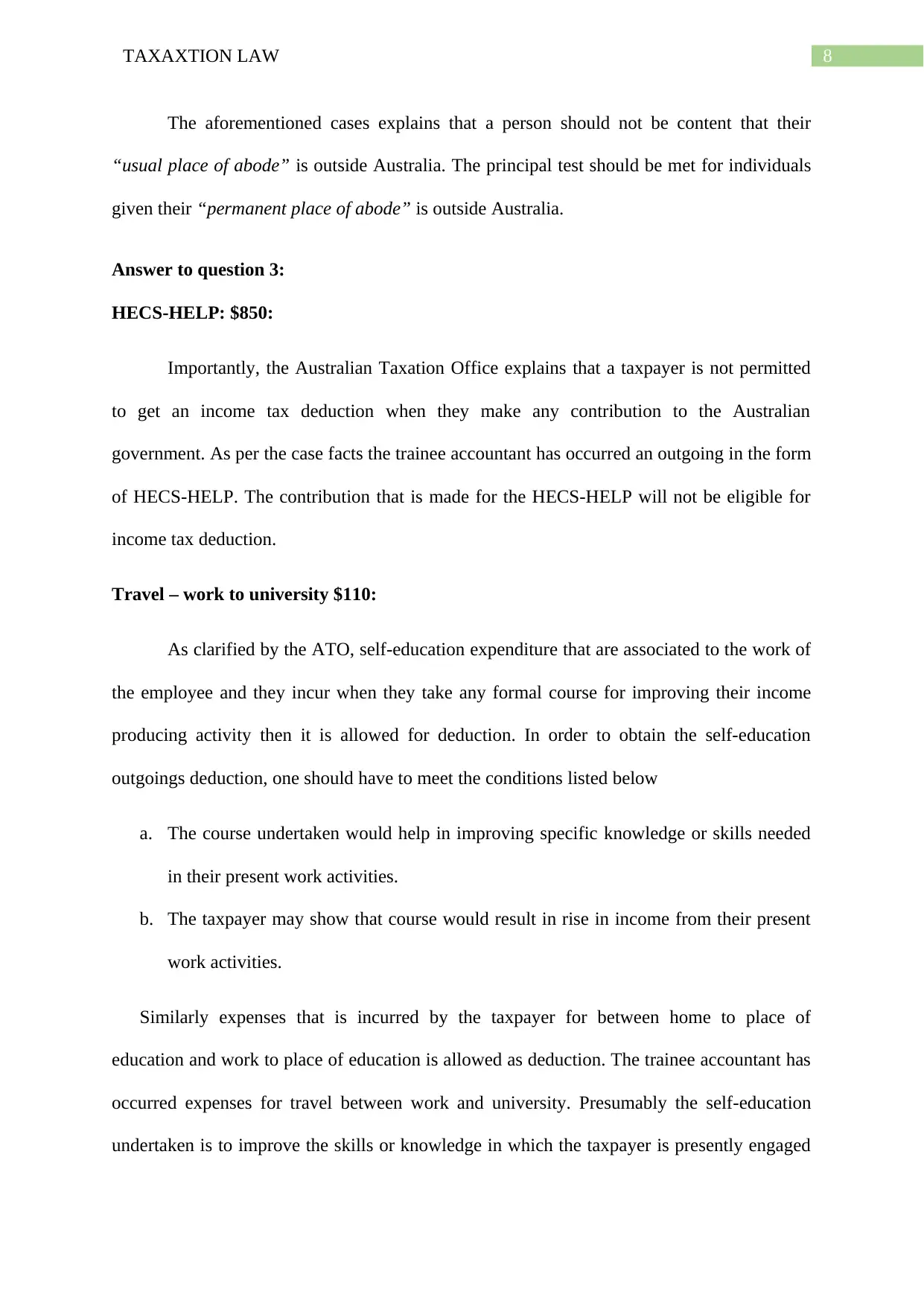
8TAXAXTION LAW
The aforementioned cases explains that a person should not be content that their
“usual place of abode” is outside Australia. The principal test should be met for individuals
given their “permanent place of abode” is outside Australia.
Answer to question 3:
HECS-HELP: $850:
Importantly, the Australian Taxation Office explains that a taxpayer is not permitted
to get an income tax deduction when they make any contribution to the Australian
government. As per the case facts the trainee accountant has occurred an outgoing in the form
of HECS-HELP. The contribution that is made for the HECS-HELP will not be eligible for
income tax deduction.
Travel – work to university $110:
As clarified by the ATO, self-education expenditure that are associated to the work of
the employee and they incur when they take any formal course for improving their income
producing activity then it is allowed for deduction. In order to obtain the self-education
outgoings deduction, one should have to meet the conditions listed below
a. The course undertaken would help in improving specific knowledge or skills needed
in their present work activities.
b. The taxpayer may show that course would result in rise in income from their present
work activities.
Similarly expenses that is incurred by the taxpayer for between home to place of
education and work to place of education is allowed as deduction. The trainee accountant has
occurred expenses for travel between work and university. Presumably the self-education
undertaken is to improve the skills or knowledge in which the taxpayer is presently engaged
The aforementioned cases explains that a person should not be content that their
“usual place of abode” is outside Australia. The principal test should be met for individuals
given their “permanent place of abode” is outside Australia.
Answer to question 3:
HECS-HELP: $850:
Importantly, the Australian Taxation Office explains that a taxpayer is not permitted
to get an income tax deduction when they make any contribution to the Australian
government. As per the case facts the trainee accountant has occurred an outgoing in the form
of HECS-HELP. The contribution that is made for the HECS-HELP will not be eligible for
income tax deduction.
Travel – work to university $110:
As clarified by the ATO, self-education expenditure that are associated to the work of
the employee and they incur when they take any formal course for improving their income
producing activity then it is allowed for deduction. In order to obtain the self-education
outgoings deduction, one should have to meet the conditions listed below
a. The course undertaken would help in improving specific knowledge or skills needed
in their present work activities.
b. The taxpayer may show that course would result in rise in income from their present
work activities.
Similarly expenses that is incurred by the taxpayer for between home to place of
education and work to place of education is allowed as deduction. The trainee accountant has
occurred expenses for travel between work and university. Presumably the self-education
undertaken is to improve the skills or knowledge in which the taxpayer is presently engaged
⊘ This is a preview!⊘
Do you want full access?
Subscribe today to unlock all pages.

Trusted by 1+ million students worldwide
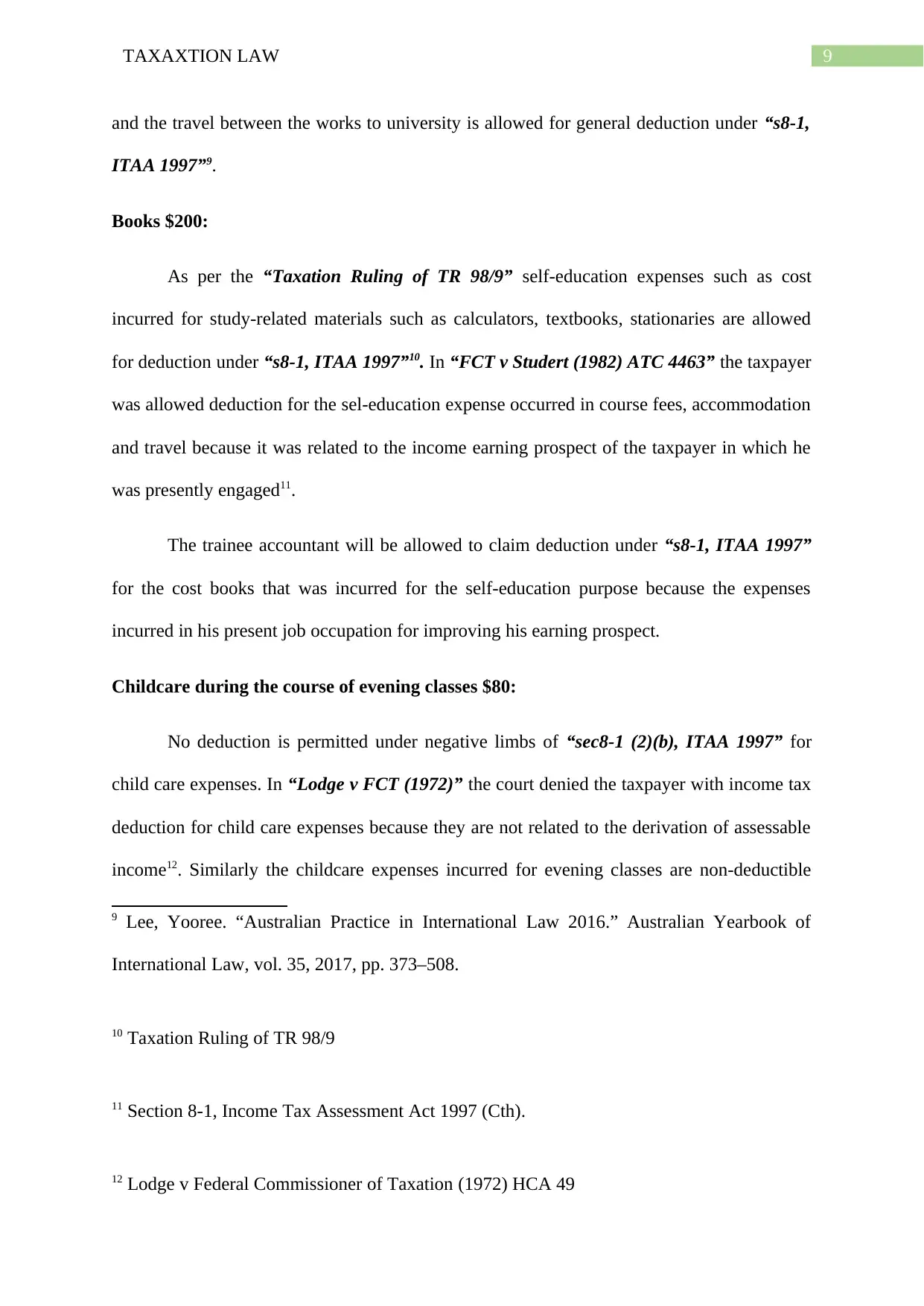
9TAXAXTION LAW
and the travel between the works to university is allowed for general deduction under “s8-1,
ITAA 1997”9.
Books $200:
As per the “Taxation Ruling of TR 98/9” self-education expenses such as cost
incurred for study-related materials such as calculators, textbooks, stationaries are allowed
for deduction under “s8-1, ITAA 1997”10. In “FCT v Studert (1982) ATC 4463” the taxpayer
was allowed deduction for the sel-education expense occurred in course fees, accommodation
and travel because it was related to the income earning prospect of the taxpayer in which he
was presently engaged11.
The trainee accountant will be allowed to claim deduction under “s8-1, ITAA 1997”
for the cost books that was incurred for the self-education purpose because the expenses
incurred in his present job occupation for improving his earning prospect.
Childcare during the course of evening classes $80:
No deduction is permitted under negative limbs of “sec8-1 (2)(b), ITAA 1997” for
child care expenses. In “Lodge v FCT (1972)” the court denied the taxpayer with income tax
deduction for child care expenses because they are not related to the derivation of assessable
income12. Similarly the childcare expenses incurred for evening classes are non-deductible
9 Lee, Yooree. “Australian Practice in International Law 2016.” Australian Yearbook of
International Law, vol. 35, 2017, pp. 373–508.
10 Taxation Ruling of TR 98/9
11 Section 8-1, Income Tax Assessment Act 1997 (Cth).
12 Lodge v Federal Commissioner of Taxation (1972) HCA 49
and the travel between the works to university is allowed for general deduction under “s8-1,
ITAA 1997”9.
Books $200:
As per the “Taxation Ruling of TR 98/9” self-education expenses such as cost
incurred for study-related materials such as calculators, textbooks, stationaries are allowed
for deduction under “s8-1, ITAA 1997”10. In “FCT v Studert (1982) ATC 4463” the taxpayer
was allowed deduction for the sel-education expense occurred in course fees, accommodation
and travel because it was related to the income earning prospect of the taxpayer in which he
was presently engaged11.
The trainee accountant will be allowed to claim deduction under “s8-1, ITAA 1997”
for the cost books that was incurred for the self-education purpose because the expenses
incurred in his present job occupation for improving his earning prospect.
Childcare during the course of evening classes $80:
No deduction is permitted under negative limbs of “sec8-1 (2)(b), ITAA 1997” for
child care expenses. In “Lodge v FCT (1972)” the court denied the taxpayer with income tax
deduction for child care expenses because they are not related to the derivation of assessable
income12. Similarly the childcare expenses incurred for evening classes are non-deductible
9 Lee, Yooree. “Australian Practice in International Law 2016.” Australian Yearbook of
International Law, vol. 35, 2017, pp. 373–508.
10 Taxation Ruling of TR 98/9
11 Section 8-1, Income Tax Assessment Act 1997 (Cth).
12 Lodge v Federal Commissioner of Taxation (1972) HCA 49
Paraphrase This Document
Need a fresh take? Get an instant paraphrase of this document with our AI Paraphraser
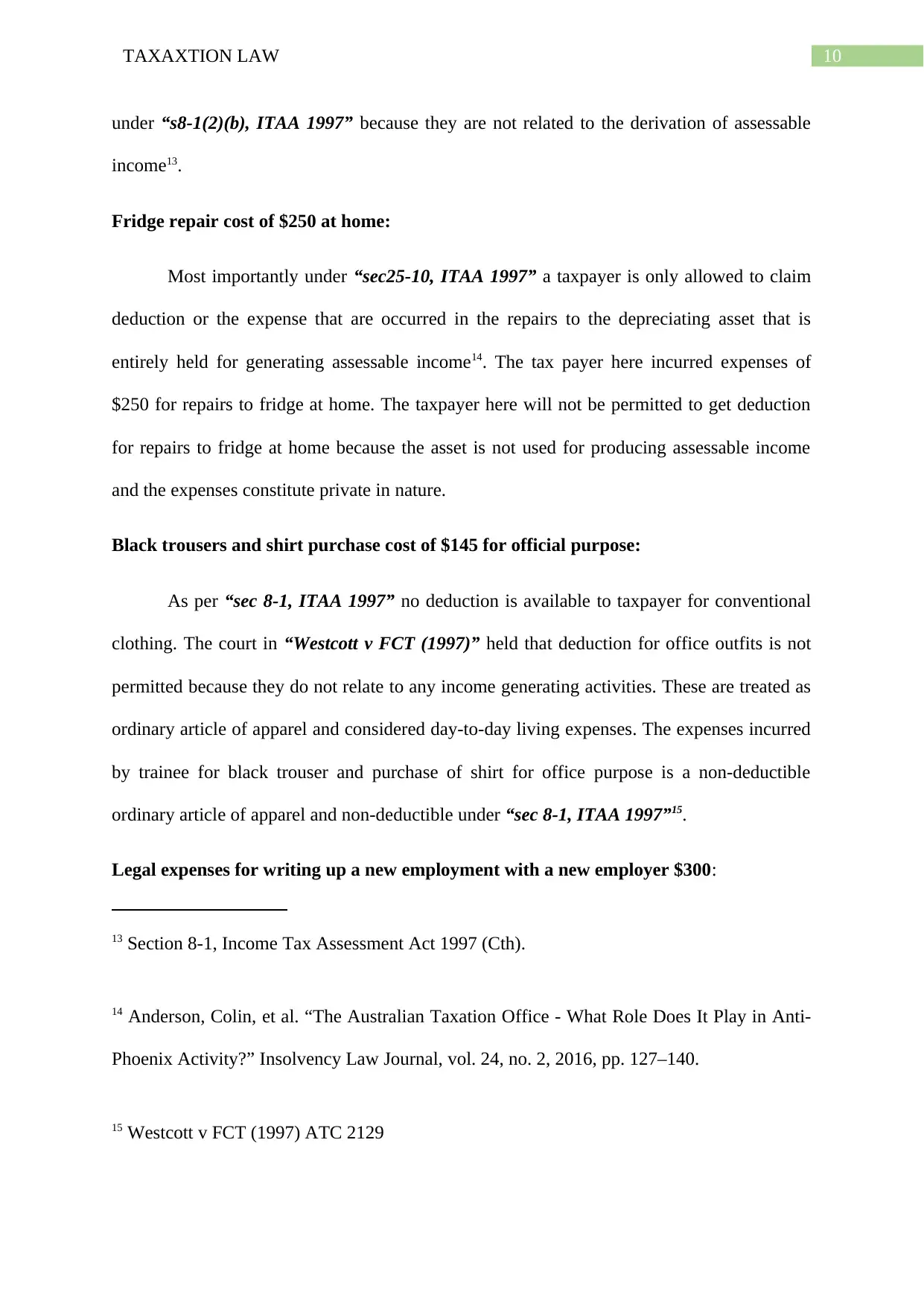
10TAXAXTION LAW
under “s8-1(2)(b), ITAA 1997” because they are not related to the derivation of assessable
income13.
Fridge repair cost of $250 at home:
Most importantly under “sec25-10, ITAA 1997” a taxpayer is only allowed to claim
deduction or the expense that are occurred in the repairs to the depreciating asset that is
entirely held for generating assessable income14. The tax payer here incurred expenses of
$250 for repairs to fridge at home. The taxpayer here will not be permitted to get deduction
for repairs to fridge at home because the asset is not used for producing assessable income
and the expenses constitute private in nature.
Black trousers and shirt purchase cost of $145 for official purpose:
As per “sec 8-1, ITAA 1997” no deduction is available to taxpayer for conventional
clothing. The court in “Westcott v FCT (1997)” held that deduction for office outfits is not
permitted because they do not relate to any income generating activities. These are treated as
ordinary article of apparel and considered day-to-day living expenses. The expenses incurred
by trainee for black trouser and purchase of shirt for office purpose is a non-deductible
ordinary article of apparel and non-deductible under “sec 8-1, ITAA 1997”15.
Legal expenses for writing up a new employment with a new employer $300:
13 Section 8-1, Income Tax Assessment Act 1997 (Cth).
14 Anderson, Colin, et al. “The Australian Taxation Office - What Role Does It Play in Anti-
Phoenix Activity?” Insolvency Law Journal, vol. 24, no. 2, 2016, pp. 127–140.
15 Westcott v FCT (1997) ATC 2129
under “s8-1(2)(b), ITAA 1997” because they are not related to the derivation of assessable
income13.
Fridge repair cost of $250 at home:
Most importantly under “sec25-10, ITAA 1997” a taxpayer is only allowed to claim
deduction or the expense that are occurred in the repairs to the depreciating asset that is
entirely held for generating assessable income14. The tax payer here incurred expenses of
$250 for repairs to fridge at home. The taxpayer here will not be permitted to get deduction
for repairs to fridge at home because the asset is not used for producing assessable income
and the expenses constitute private in nature.
Black trousers and shirt purchase cost of $145 for official purpose:
As per “sec 8-1, ITAA 1997” no deduction is available to taxpayer for conventional
clothing. The court in “Westcott v FCT (1997)” held that deduction for office outfits is not
permitted because they do not relate to any income generating activities. These are treated as
ordinary article of apparel and considered day-to-day living expenses. The expenses incurred
by trainee for black trouser and purchase of shirt for office purpose is a non-deductible
ordinary article of apparel and non-deductible under “sec 8-1, ITAA 1997”15.
Legal expenses for writing up a new employment with a new employer $300:
13 Section 8-1, Income Tax Assessment Act 1997 (Cth).
14 Anderson, Colin, et al. “The Australian Taxation Office - What Role Does It Play in Anti-
Phoenix Activity?” Insolvency Law Journal, vol. 24, no. 2, 2016, pp. 127–140.
15 Westcott v FCT (1997) ATC 2129
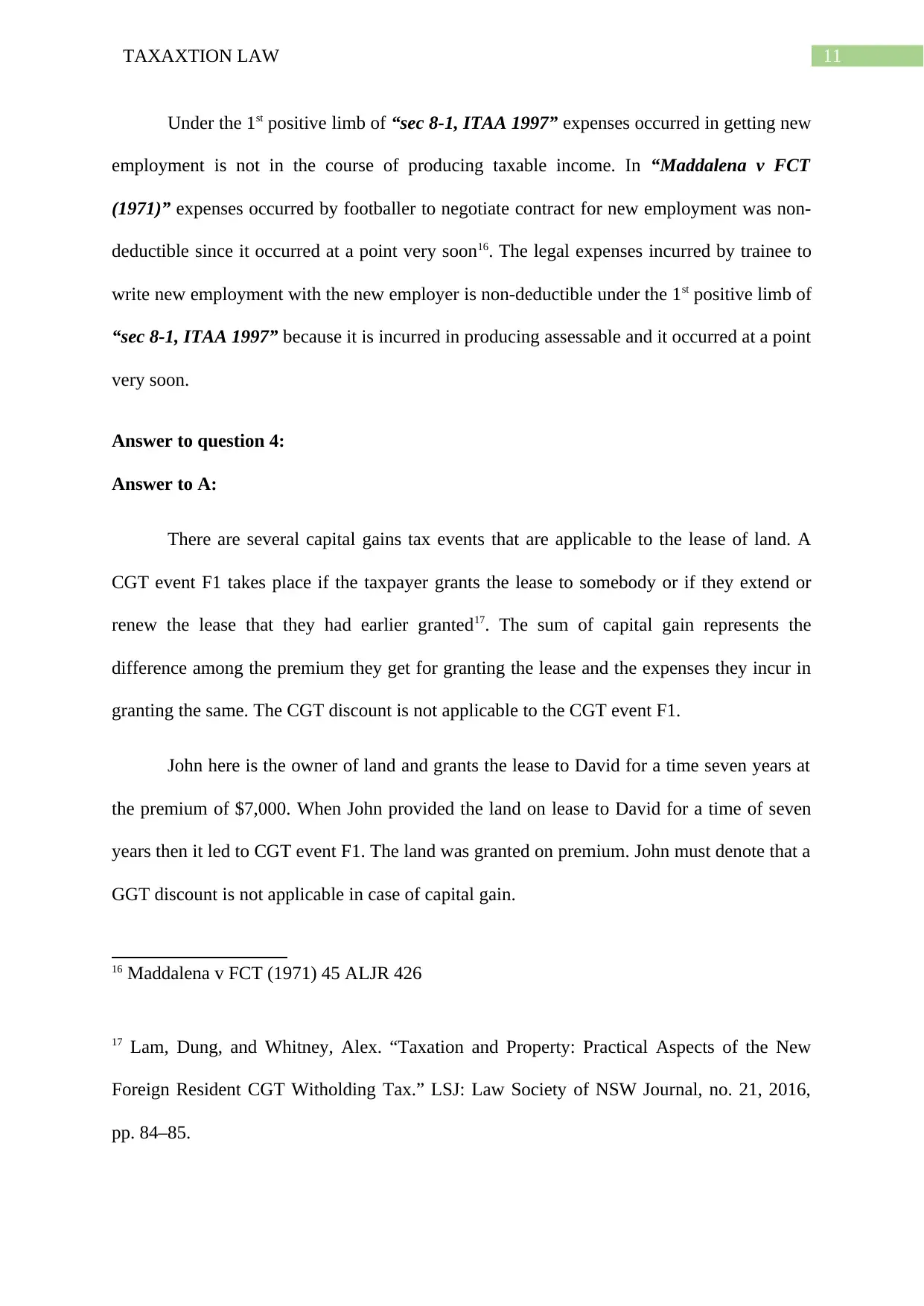
11TAXAXTION LAW
Under the 1st positive limb of “sec 8-1, ITAA 1997” expenses occurred in getting new
employment is not in the course of producing taxable income. In “Maddalena v FCT
(1971)” expenses occurred by footballer to negotiate contract for new employment was non-
deductible since it occurred at a point very soon16. The legal expenses incurred by trainee to
write new employment with the new employer is non-deductible under the 1st positive limb of
“sec 8-1, ITAA 1997” because it is incurred in producing assessable and it occurred at a point
very soon.
Answer to question 4:
Answer to A:
There are several capital gains tax events that are applicable to the lease of land. A
CGT event F1 takes place if the taxpayer grants the lease to somebody or if they extend or
renew the lease that they had earlier granted17. The sum of capital gain represents the
difference among the premium they get for granting the lease and the expenses they incur in
granting the same. The CGT discount is not applicable to the CGT event F1.
John here is the owner of land and grants the lease to David for a time seven years at
the premium of $7,000. When John provided the land on lease to David for a time of seven
years then it led to CGT event F1. The land was granted on premium. John must denote that a
GGT discount is not applicable in case of capital gain.
16 Maddalena v FCT (1971) 45 ALJR 426
17 Lam, Dung, and Whitney, Alex. “Taxation and Property: Practical Aspects of the New
Foreign Resident CGT Witholding Tax.” LSJ: Law Society of NSW Journal, no. 21, 2016,
pp. 84–85.
Under the 1st positive limb of “sec 8-1, ITAA 1997” expenses occurred in getting new
employment is not in the course of producing taxable income. In “Maddalena v FCT
(1971)” expenses occurred by footballer to negotiate contract for new employment was non-
deductible since it occurred at a point very soon16. The legal expenses incurred by trainee to
write new employment with the new employer is non-deductible under the 1st positive limb of
“sec 8-1, ITAA 1997” because it is incurred in producing assessable and it occurred at a point
very soon.
Answer to question 4:
Answer to A:
There are several capital gains tax events that are applicable to the lease of land. A
CGT event F1 takes place if the taxpayer grants the lease to somebody or if they extend or
renew the lease that they had earlier granted17. The sum of capital gain represents the
difference among the premium they get for granting the lease and the expenses they incur in
granting the same. The CGT discount is not applicable to the CGT event F1.
John here is the owner of land and grants the lease to David for a time seven years at
the premium of $7,000. When John provided the land on lease to David for a time of seven
years then it led to CGT event F1. The land was granted on premium. John must denote that a
GGT discount is not applicable in case of capital gain.
16 Maddalena v FCT (1971) 45 ALJR 426
17 Lam, Dung, and Whitney, Alex. “Taxation and Property: Practical Aspects of the New
Foreign Resident CGT Witholding Tax.” LSJ: Law Society of NSW Journal, no. 21, 2016,
pp. 84–85.
⊘ This is a preview!⊘
Do you want full access?
Subscribe today to unlock all pages.

Trusted by 1+ million students worldwide
1 out of 19
Related Documents
Your All-in-One AI-Powered Toolkit for Academic Success.
+13062052269
info@desklib.com
Available 24*7 on WhatsApp / Email
![[object Object]](/_next/static/media/star-bottom.7253800d.svg)
Unlock your academic potential
Copyright © 2020–2025 A2Z Services. All Rights Reserved. Developed and managed by ZUCOL.





